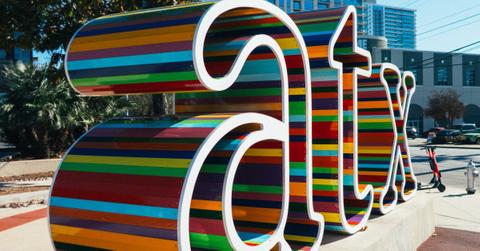The Austin Yogurt Shop Murders: The Unsolved Brutal Quadruple Homicide of Four Teenage Girls (FPD CASE VAULT)

March 14 2024, Published 10:03 a.m. ET
It was close to midnight on Dec. 6, 1991, in Austin, Texas, that a patrolman saw smoke coming from the rear of I Can't Believe It's Yogurt on Anderson Lane's strip mall. He immediately called for assistance, and up to 50 firefighters from the fire department duly brought the blaze under control. Being forced to break down the door as the key was in the lock, firefighters hunted through the burnt debris and soon discovered this was no ordinary fire.
The bodies of four girls were found amidst the wreckage, all nude, with some having their hands tied. The cash register was empty.
The four dead were Amy Ayers, 13, Eliza Thomas, 17, and sisters Jennifer, 17, and Sarah Harbison, 15. Three of the four had been executed by a .22-caliber single bullet to the back of the head while Ayers had been shot twice; the first bullet had missed her brain, and she was also strangled with a sock-like ligature, presumably after she didn't die as expected. All the victims except Ayers suffered extensive charring, and Sarah Harbison was tied up with her own panties and raped. An accelerant was likely used to set the shop and bodies on fire.
"You can't help but relive those images, and I still see the images," former Austin firefighter Rene Garza told KXAN in 2016. "The firefighter with me tapped me on the shoulder and pointed down, and he asked me, 'Is that a body?' And I had to step back. It was, and I saw another body. I knew that it wasn't right. Something was not right."
Investigation of the crime scene revealed that all four girls had initially been piled on top of one another. However, the still alive Ayers had managed to crawl away to a separate part of the shop, meaning her body didn't suffer the charring of her friends, instead suffering second and third-degree burns.
Because the crime scene was extensively burnt and drenched in water, evidence was hard to come by. Firefighters repeatedly entered the property in the first hours after the fire was put out, with Austin Fire Department paramedics and arson investigators following, then the Travis County medical examiner and finally crime scene investigators from the Department of Public Safety. The disruption was immense. The first Austin police officer on the scene, Det. John Jones, later said, "There were enough people in that we couldn't control everything that was going out the doors."
AN ACTIVE INVESTIGATION
Even when CSI was on the scene, mistakes were made with items failing to be saved and whole shop areas not being processed, such as the bathrooms, a dumpster and the front door. Police eventually found several bullet casings and a magazine for a semi-automatic handgun, alongside fingerprints and DNA evidence from five hairs on the girls’ bodies. The remains of girls' clothes were found piled in a corner near the rear door, with police finding denim fabric, a heart-shaped belt buckle that had belonged to Ayers but no belt, and a ring belonging to Sarah Harbison's boyfriend.
Police immediately began to reconstruct the events of the previous night. Jennifer Harbison and Thomas had been employees at the store, with the other two girls being friends, there to hitch a ride home and help close up when the store was due for closing at 11p.m. Earlier in the day, Jennifer Harbison had arrived home. She discussed plans to have Ayers over for a sleepover, with Maria Thomas, mother of Eliza Thomas, having stopped by at the yogurt shop at 9:45 p.m. and James Thomas, Eliza's father stopping by at 10 p.m.
Before closing, a man had been observed causing trouble in the store, harassing patrons and asking one if he was a police officer. The individual asked to use the toilet and took a long time to do so, which led to speculation that he may have jammed the back door open, this being the way the killer or killers exited the building.
Alongside the suspicious individual in the toilet, another patron reported two other men acting strangely at a table just before closing. Police now believe the nature of the crime meant they were looking for adult perpetrators rather than anyone close to the age of the victims.

Austin, Texas
However, on Dec. 14, 1991, police would pick up and interview 15-year-old Maurice Pierce after he was found to be carrying a gun at Northcross Mall in Austin just days later. The boy was seemingly cooperative and gave information on friends and acquaintances who were known, small-time criminals. It soon became apparent that he was merely trying to avoid the rap for the gun charge, and both he and his friends were eliminated from inquiries. The four were Pierce, Michael Scott, Robert Springsteen and Forrest Wellborn.
With the case having gone nearly cold, some years after the killings, a new detective on the matter, Paul Johnson, would revisit the four teenage suspects. He concluded they had been in the frame, despite the profile of the perpetrator or perpetrators saying that the way the victims had been controlled, the destruction of evidence and the organization with which the crime had been carried out showed explicit adult and experienced traits.
The four suspects were taken in and questioned by various detectives in Texas and West Virginia on Oct. 6, 1999. Springsteen, then 24, was arrested in Charleston, West Virginia. Scott, then 25, was picked up in the Austin area. Pierce, then 24, was arrested in Lewisville, Texas, and Wellborn, 23, was found in Lockhart, Texas.
Confessions were obtained from some of the suspects, including Scott, who broke after an 18-hour interview on Sept. 14, 1999. Springsteen confessed the day after, claiming to have shot Ayers with a .380-caliber pistol. A written statement from Pierce had already said that Welborn had committed the murders with the .22-caliber handgun he'd been picked up with at Northcross Mall.
PROBLEMS WITH THE INTEVIEWS
During the interrogation of Springsteen, Det. Robert Merrill sat blocking the exit to the room. At the same time, his colleague Det. Ron Lara and occasionally Alcohol, Tobacco and Firearms federal agent Chuck Meyer would yell inches from his face. "I don't know whether this is true or not, or whether I'm fooling myself," Springsteen would say on the tape. "I'm so confused."
The gun was never found, though witnesses confirmed Springsteen owned such a weapon. Meanwhile, ballistics experts had concluded that the weapon found on Pierce back in 1991 was not the .22-caliber weapon used in the killings.
However, there was a significant issue with the interviews, with no records from the original 1991 interviews. If the suspects referenced anything they may have been told, it could be used against them as having knowledge of the crime. It was unknown what he'd been informed of previously, what crime scene photos he'd been shown, and what he may have heard in media reports that had leaked vital facts in the case.
Springsteen never mentioned the victims having been tied up, nor about the back room where the bodies were found being set on fire. He also made a mistake when talking about how he had apparently killed Ayers, stating that he first shot her with a .380-caliber weapon and then, when she survived, blasted her with a .22-caliber gun. Medical examiners had already ascertained it was the .380 weapon that had killed the girl and been fired second. Springsteen also never mentioned the sock-like ligature.
However, there were also facts that police believed were not public knowledge or that corroborated the confession of Scott the previous day. These included the other weapon being a .380-caliber semi-automatic, Scott attempting to rape one of the girls and the rear door of the yogurt shop had been wedged open with an empty cigarette pack or a small rock.

Austin, Texas
Equally, one of those partaking in the interrogations, Det. Hector Polanco, had been accused of extracting false confessions in the case of Christopher Ochoa and Richard Danziger. The case bears some similarity to the Yogurt shop murders and centered around the 1988 rape and murder of Nancy DePriest at Pizza Hut in Austin. DePriest had been tied up with her own bra, raped, and then shot in the head.
Ochoa pleaded guilty to the killing, and his friend Danziger was convicted of rape after being implicated by Ochoa's false confession under harassment and threats of receiving the death penalty. Years later, a prisoner by the name of Achim Marino underwent a religious awakening. In letters to the police, then-Gov. George W. Bush, and the district attorney, he confessed to the killing and confirmed neither Ochoa nor Danziger had anything to do with it. However, freedom came too late for Danziger, suffering severe brain damage in a prison assault and being housed in a mental institution.
Three of the four Austin yogurt shop suspects were initially sent to trial, Scott, Pierce and Springsteen. Only Springsteen and Scott would eventually be prosecuted beginning in June of 2001, with Springsteen facing the death penalty.
THE PROSECUTION
The lead prosecutor on the case, Robert Smith, said in his opening statements that it had been Springsteen who initially "cased" the store and was the individual who secured the back door to ensure it didn't lock. The intent was a robbery. Springsteen didn't realize that Ayers and Sarah Harbison would be helping their friends close-up, now being confronted by four girls instead of two. He was accompanied into the shop by Scott and Pierce while the fourth teenager, Wellborn, was the getaway man for who there wasn't enough evidence to prosecute. Two grand juries in Travis County failed to indite Wellborn, and charges were dropped in 1999.
There was plenty of circumstantial evidence presented, such as Springsteen owing a .380-caliber weapon and Pierce stealing a Nissan Pathfinder the day afterward. However, the only real evidence against them, as in the DePriest case, was their confessions which Springsteen maintained had been coerced, telling jurors, "If I just make up a bunch of stories and tell them what they want to hear... the evidence will show it couldn't have been me."

Austin, Texas
Both were convicted after an emotive prosecution where the focus was on the horror of the crimes committed against four young girls rather than presenting any actual evidence. Springsteen received the death penalty, and Scott received life in prison on account of being only 15 at the time of the murders.
Speaking to the press outside the courtroom, Dr. Richard Ofshe, a professor of social psychology at the University of California at Berkeley, said that "Tactics were used that put [Springsteen] in a place of being considered the principal target. Or, it was communicated to him that [if he cooperated] that he'd be considered a victim. So, Springsteen was put in a position where he had to choose."
The duo immediately appealed, and it was found that a prosecution tactic of using one suspect's confession against another violated the Confrontation Clause of the 6th Amendment. The document states, "in all criminal prosecutions, the accused shall enjoy the right… to be confronted with the witnesses against him," and at Scott and Springsteen's trial, neither testified against the other. The Texas Court of Criminal Appeals overturned the case against Springsteen in 2006, and the Supreme Court refused to reinstate the conviction the following year.
However, the court found that both men's confessions had been freely given, with Presiding Judge Sharon Keller maintaining that the "confession was voluntary. [Springsteen] had no motive to confess falsely, and there was absolutely no reason for the jury to doubt the truthfulness of the confession. [Springsteen] knew that a .380 semi-automatic handgun was used in the murders, and this information was a closely guarded secret."
Both men were scheduled to face a re-trial over the killings yet were set free in June on personal recognizance bonds after new DNA evidence was discovered that did not belong to Springsteen, Scott or any of the other teenagers. The more than 130 people present at the crime scene were tested, including police and firefighters, with no matches found to the unknown male sample. All charges were dismissed that October, with District Attorney Rosemary Lehmberg saying she was "confident that both Springsteen and Scott [were responsible] for the deaths at the yogurt shop."
WHAT HAPPENED?
But if Lehmberg was wrong and Springsteen and Scott hadn't been responsible, then who was?
There were many confessions over the killings, with police receiving at least 50 claims of responsibility, an astonishing number. Notably, some of these confessions contained the same facts that police found suspicious about the Springsteen and Scott interviews, suggesting that what Austin police believed wasn't public knowledge; in fact, had been.

Austin, Texas
For example, Alex Brionnes, who was wanted in connection with setting a woman on fire in San Antonio, knew that some of the girls were all bound, gagged, raped and shot. He knew about the second weapon, what that gun looked like, and that napkins and cardboard had been piled on top of the bodies before the fire. Some of the information was supposed to be confidential. At the trial, Assistant District Attorney Efraim de la Fuente made it clear that the false confession was made under coercion by Polanco.
Shawn Smith, an Austin resident who voluntarily confessed in 1992, said that he and friends arrived at the yogurt shop and then stripped and bound the victims. He knew one of the guns was "an automatic of some sort," and that lighter fluid had been used as the accelerant after stacking the bodies.
One of the other names in the frame for the Austin yogurt shop murders was serial killer Kenneth Allen McDuff. McDuff's name was raised at the trial of Scott and Springsteen, with it being noted that he was in Austin and had a map in his car that would have placed him within just three blocks of the yogurt shop. Not only that, but a witness at Northcross Mall claimed to have even seen him on the night of the killings.
Still in town, McDuff abducted a woman named Colleen Reed from a car wash in the city on Dec. 29, 1991. McDuff was assisted in the plain sight kidnapping by accomplice Alva Hank Worley, admitting in a 1992 interview that he raped and tortured the woman, blaming Worley for the murder.
Still in town, McDuff abducted a woman named Colleen Reed from a car wash in the city on Dec. 29, 1991. McDuff was assisted in the plain sight kidnapping by accomplice Alva Hank Worley, admitting in a 1992 interview that he raped and tortured the woman, blaming Worley for the murder.
The confessions of Brionnes, Smith, McDuff and others weren't taken seriously as they lacked details of the crime, yet many of them knew things that police believed should have been confidential, just like Springsteen and Scott.
Such was the alarm amongst police in Austin that many feared there had been a leak of information somewhere. However, it seems more likely that the constant questioning of dozens of teenagers had simply allowed gossip to filter uncontrollably through the local area.
The Austin yogurt shop murders was one of the most brutal crimes in the history of Texas capital, with the lives of four young girls taken in a most terrible way.
However, the investigation was bungled from the start, with the already ruined crime scene compromised and, in some places, not even analyzed. Police techniques in ensuring a confession and focusing on teenage suspects came back to haunt them, with no physical evidence and information freely available to the public, guaranteeing multiple false confessions. The cases against Springsteen and Scott were wafer-thin.
Unless the DNA evidence from the scene one day provides results or, ironically, a new confession emerges, it seems likely that the four horrific killings will remain unsolved.
Become a Front Page Detective
Sign up to receive breaking
Front Page Detectives
news and exclusive investigations.
